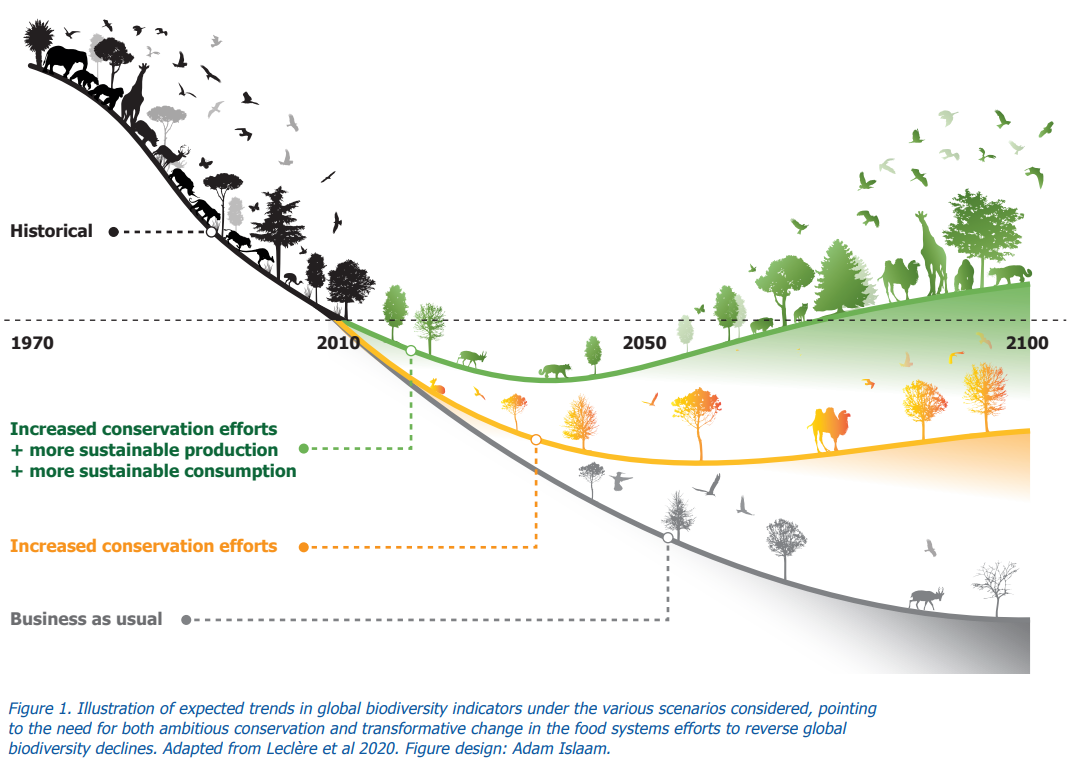
Policy Brief #33, January 2022. Action on biodiversity loss can be much more effective if it embraces other global challenges.
Recent research is showing how to simultaneously tackle biodiversity loss and climate change, while addressing other sustainable development goals. This work can aid implementation of the new Global Biodiversity Framework, as well as international efforts on climate mitigation and securing food supplies. It can help policymakers to:
- Integrate goals and interventions. Analysis by IIASA shows the advantages of combining conservation efforts with measures on food supply and demand. Biodiversity trends can be turned around sooner without threatening food security and with benefits for climate mitigation, water use, and human health.
- Prioritize conservation of key sites for climate and biodiversity. New IIASA prioritization tools can show where conservation management is likely to bring the greatest benefits for biodiversity, carbon storage, and water quality.
- Integrate conservation and food production beyond protected areas. IIASA research highlights the benefit of planning for biodiversity and food production together, rather than separately, across all land areas.
Deeply entangled issues
With biodiversity continuing to decline rapidly despite conservation efforts, the Convention on Biological Diversity (CBD) is aiming to finalize a new plan to reverse this trend. The CBD’s scheduled meeting in Kunming, China, in spring 2022 follows two other critical UN summits on climate and food systems, both in late 2021.
These separate summits address issues that are deeply entangled. Climate change, development, and biodiversity loss share both causes and solutions. For example, biodiversity loss stems from climate change, habitat loss, pollution, groundwater extraction, overfishing, and invasive species – all caused by unsustainable human activities. Efforts to conserve and restore ecosystems will affect climate, as well as the availability of food and clean water.
IIASA research shows that any effort to tackle biodiversity loss must be part of an integrated approach: combining policies in different fields and assessing impacts on all the desired outcomes.
Combine forces
On a global scale, the power of an integrated approach is shown clearly in an IIASA-led study modeling how various actions may affect biodiversity.
The study finds that conservation and restoration alone have limited effects, even if undertaken on an ambitious scale. In one scenario, protected areas cover 40% of global land, and 5 million km2 of degraded land is restored by 2050. This leads to global biodiversity trends starting to slowly improve around 2050 in some, but not all models. The constraints on land use may however cause a rise in global food prices, likely to undermine the UN Sustainable Development Goal of zero hunger.
Another scenario shows the effect of adding actions to tackle the drivers of habitat loss: improving food supply through trade and sustainable yield increases, and reducing demand though less food waste and a lower share of animal products in diets. According to model projections, this combined approach sees biodiversity trends turn positive before 2050, without increasing food prices. The co-benefit for climate is substantial: relative to the conservation/restoration only scenario and averaged across models, it leads to a roughly 30% fall in greenhouse gas emissions from agriculture, forestry, and other land uses (which amount to just over 20% of all current GHG emissions). The integrated action scenario also puts less strain on water resources, requires less use of polluting nitrogen fertilizers, and leads to healthier diets. This shows how humanity might bend the curve of biodiversity loss without threatening food security and sustainable development.
 © IIASA, Adam Islaam
© IIASA, Adam Islaam
Choose your ground
The draft Global Biodiversity Framework, now being discussed as the CBD’s next 10-year plan, puts an emphasis on area-based targets – notably, aiming for 30% of global land and sea areas to be managed for conservation. But how to choose that 30%?
Tools developed at IIASA have shown how spatial planning for conservation can maximize benefits for biodiversity and other vital objectives. One recent study looked at targeting priority land areas for conservation, calculating the effects on species conservation, carbon storage, and clean water availability. Optimizing all three objectives with equal weight, the study identified sites totaling 30% of land area that, if conserved, could help bring up to 81% of terrestrial vertebrate and plant species to the lowest extinction risk category, while retaining more than 60% of biomass carbon and preserving about 66% of clean water resources.
Plan for the whole planet
Protecting so much land for conservation risks some conflict with agricultural land-use – potentially affecting food production and livelihoods. To prevent that, it will be vital to look beyond protected areas: extending land-use planning across the rest of the world, integrating targets for species conservation and food production.
A recent study from IIASA examined the consequences of such integrated planning – making 100% of the planet available for whatever land use makes most sense to achieve all objectives with minimum trade-offs. Compared with the separated approach (relying only on protected areas for biodiversity and everywhere else for food) this integrated approach could reach the same species conservation objectives with only 25-40% of the opportunity cost for food production.
The draft Global Biodiversity Framework now includes a 2030 target of having all land and sea areas globally under integrated biodiversity-inclusive spatial planning. This study shows how vital it is to retain that target.
 © IIASA
© IIASA
New policy tools and evidence
The maps produced in these studies highlight areas of global conservation importance, but are too coarse grained to use for selecting specific sites or suggesting specific management actions. Where such decisions are to be made, the modeling tools developed in these studies can be applied locally: based on fine-grained data, and participatory processes and feedback with affected stakeholders to define local priorities. Site selection needs to be undertaken with free, prior, and informed consent of all parties, including marginalized or indigenous communities, and such an exercise should also delineate appropriate governance and financing schemes, including rights-based approaches.
The broad message is that policies should not be oriented to a single goal but based on assessments across dimensions, encompassing not only biodiversity, but climate, food, equity, and other objectives. One emerging attempt at such an integrated approach is a new IIASA-led project - EU BIOCLIMA. It looks at land-use policies of EU national member states, which have a range of objectives, and simulates outcomes for biodiversity and carbon to explore synergies, co-benefits, and trade-offs. This approach could serve as a blueprint for other integrated national policy assessments.
The work described above adds to the amount of evidence and policy guidelines, which have been synthetized in an information document for negotiators of the post-2020 Global Biodiversity Framework of the CBD.
Publications which this policy brief is based on
Leclère, D., Obersteiner, M., Barrett, M., Butchart, S.H.M., Chaudhary, A., De Palma, A., DeClerck, F.A.J., Di Marco, M., et al. (2020). Bending the curve of terrestrial biodiversity needs an integrated strategy. Nature 585 551-556.
Fastré, C., van Zeist, W.-J., Watson, J.E.M., & Visconti, P. (2021). Integrated spatial planning for biodiversity conservation and food production. One Earth
Jung, M., Arnell, A., de Lamo, X., García-Rangel, S., Lewis, M., Mark, J., Merow, C., Miles, L., et al. (2021). Areas of global importance for conserving terrestrial biodiversity, carbon and water. Nature Ecology & Evolution 5 1499-1509.
Leadley, P., Krug, C., Obura, D., Shannon, L., Gonzalez, A., Londoño-Murcia, M.C., Radulovici, A., Millette, K. et al. (2022). Expert input to the post-2020 global biodiversity framework: transformative actions on all drivers of biodiversity loss are urgently required to achieve the global goals by 2050.
References and useful resources
Díaz, S., Zafra-Calvo, N., Purvis, A., Verburg, P.H., Obura, D., Leadley, Paul, Chaplin-Kramer, R., De Meester, L., et al. (2020). Set ambitious goals for biodiversity and sustainability. Science 370 (6515) 411-413.
European Union Biodiversity and Climate strategies Assessment (EU BIOCLIMA)
IIASA Policy Briefs report on research carried out at IIASA and have received only limited review. Views or opinions expressed herein do not necessarily represent those of the institute, its National Member Organizations, or other organizations supporting the work.


